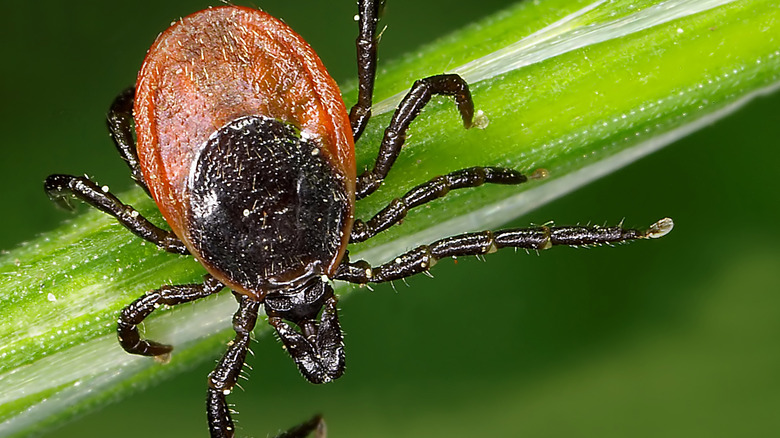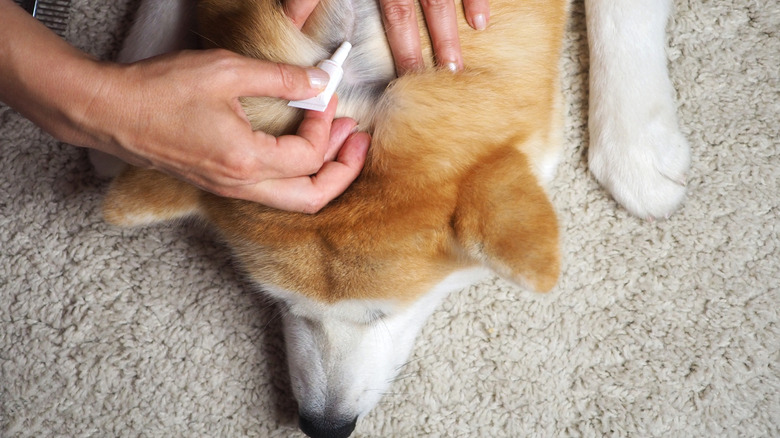Tick Hiding Spots On Your Dog
We may receive a commission on purchases made from links.
Ticks continue to pose a significant threat to dogs. Potential illnesses they can carry include Rocky Mountain spotted fever, Lyme disease (borreliosis), ehrlichiosis, and more. Some of these conditions, like Lyme disease, are potentially fatal or can result in long-term issues like lameness and pain. Moreover, the Companion Animal Parasite Council (CAPC) 2024 pet parasite forecast noted that parasite-borne illnesses in pets and people have been continually rising, with rates tripling from 2004 to 2016 and a moderate increase in the prevalence of Lyme disease between 2023 and 2024.
It takes at least 24 hours for a tick to transmit disease once it has latched on. For this reason, pet parents should check for ticks in a dog's warm and hidden areas, sometimes called "tick hot spots," daily — especially if you live in an area with a large tick population. It's best to check the face, ears, toes, tail, groin, eyelids, under the collar, and in the armpits of your pet. Regularly checking your pet using your fingers to feel for bumps or a fine-toothed comb to part their hair and remove any embedded ticks can help prevent diseases from this pest.
How to identify ticks and when to check for them
There are thirteen types of ticks in the US. These include the common American dog tick, predominantly found on the Pacific Coast and east of the Rockies, and the black-legged deer tick found throughout the eastern, north-central, and southern states. Although each tick species differs slightly in appearance, ticks have eight legs, tend to be brown, reddish-brown, or dark gray, and will inflate as they feed. Still, some pet parents have issues telling the difference between ticks, mites, fleas, and other pests. The Canadian Veterinary Medical Association highlights in their video how it can be challenging to identify ticks, and shows how you can identify them more easily — without mistaking them for other things.
Understanding the behavior of ticks is key to being a prepared pet owner. Ticks are seasonal pests, with nymphs (between larval and adult size) most active during spring and summer. Comparatively, adult ticks are more active during the fall. Ticks are likelier to be out when temperatures rise above 39 degrees Fahrenheit. However, certain ticks, like the blacklegged (deer) tick, can survive in winter and become active in spaces without snow when the temperature rises above freezing. A diligent pet owner should check their dog regularly during the active seasons, particularly after outdoor activity in warm, damp areas where ticks may thrive.
Best ways to prevent tick-borne illnesses
The best way to avoid tick-related illnesses — beyond regularly checking your pet's body — is to take preemptive measures. Luckily, there are various viable options to help prevent tick bites, including collars, topical creams, and oral medication. These options do not stop ticks from biting but have a fast kill time once they latch on, preventing the transmission of diseases and stopping them from taking a blood meal. Collars and topical agents can last longer between applications than oral medications. Before deciding, it's best to speak with your veterinarian to pick the safest, easiest, and most affordable options for your budget.
It can be daunting for pet parents to remove ticks from sensitive areas like eyelids. However, any attached tick must be removed when discovered. This process involves grasping the head of the tick with tweezers, pulling the pest straight out rather than twisting, and ensuring that no part of the tick has stayed embedded in your pet's skin. A cold compress can help alleviate swelling, and a caretaker can apply an ointment like Dr. Pol's Incredi-Pol Wound Gel afterward.
If a pet parent suspects a tick has been attached to their pet for 24 hours or more, if the pet shows any signs of illness such as fever, loss of appetite, or lethargy, or if the owner cannot remove the tick, they should consult a veterinarian. Checking your pet regularly in any problem spots can help ensure you catch any ticks on your pet's body before they become a problem.


